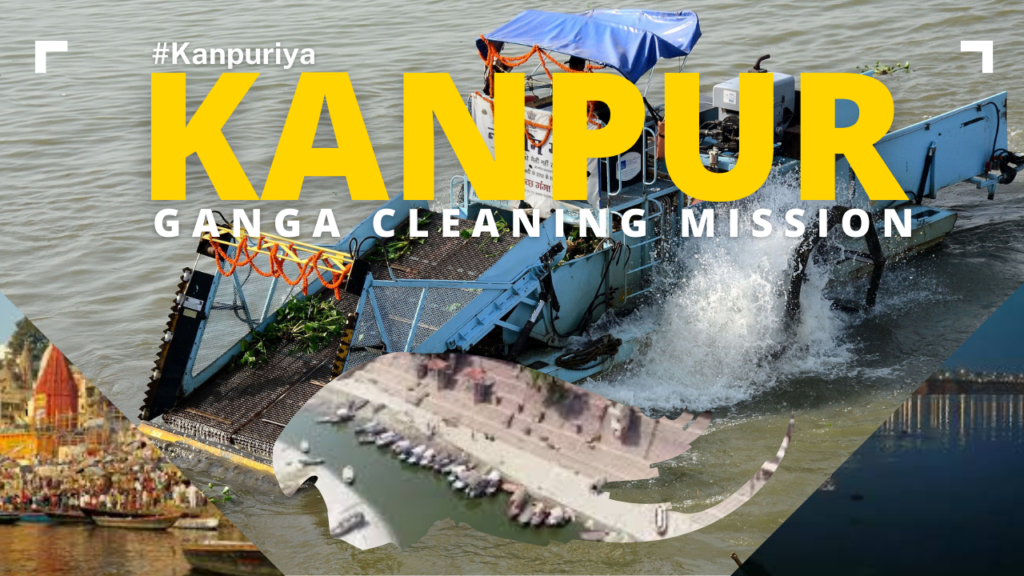The Ganga River, often revered as a lifeline for millions, has historically faced significant pollution challenges, particularly in industrial cities like Kanpur. The “Namami Gange Programme,” launched in 2014, aims to rejuvenate the river by addressing pollution sources and promoting conservation efforts. This article examines Kanpur’s progress in combating Ganga pollution, highlighting key initiatives, current status, challenges, and future prospects.

Background: Kanpur’s Industrial Impact on the Ganga
Kanpur, a major industrial hub in Uttar Pradesh, has been a focal point for pollution in the Ganga River. The city hosts numerous tanneries, textile units, and chemical industries, which have historically discharged untreated effluents into the river. Additionally, inadequate sewage infrastructure has led to the flow of domestic waste into the Ganga, exacerbating pollution levels.
Namami Gange Programme: A National Initiative
Launched in 2014 with a budget outlay of ₹20,000 crore, the Namami Gange Programme is an integrated conservation mission approved as a flagship programme by the Union Government. It aims to accomplish the twin objectives of effective abatement of pollution and conservation and rejuvenation of the National River Ganga.
Key Initiatives in Kanpur
Several critical measures have been implemented in Kanpur under the Namami Gange Programme:
- Sewage Treatment Plants (STPs): To address domestic waste, multiple STPs have been established:
| Location | Capacity (MLD) |
|---|
| Bingawan | 210 |
| Jajmau | 205 |
| Sajari | 42 |
| Pankha | 30 |
2. Common Effluent Treatment Plant (CETP): A 20 MLD CETP is under construction for the Jajmau tannery cluster, the largest of its type in the country, addressing industrial pollution from tanneries.
3. Drain Interception and Diversion: Drains like the Sisamau Nala, which previously discharged directly into the Ganga, have been intercepted and diverted to STPs, curbing the flow of untreated waste into the river. The News Mill
4. Real-Time Monitoring: The PRAYAG platform, established on April 20, 2023, facilitates continuous monitoring of river water quality and the performance of treatment plants along the Ganga and Yamuna rivers. Press Information Bureau
Current Status and Impact
The implementation of these initiatives has led to measurable improvements:
- Reduction in Pollution Load: The operational STPs and CETPs have substantially decreased the volume of untreated sewage and industrial effluents entering the Ganga.
- Water Quality Enhancement: Continuous monitoring indicates improvements in key water quality parameters, contributing to the river’s ecological health.
Challenges and Ongoing Efforts
Despite progress, several challenges persist:
- Untapped Drains: As of January 2025, out of 26 drains in Kanpur Nagar, six remain untapped, discharging directly into the Ganga. A comprehensive plan has been formulated to address these drains, with proposals submitted to the National Mission for Clean Ganga (NMCG) for approval. Times of India
- Industrial Compliance: Ensuring consistent adherence to environmental regulations by industries requires ongoing vigilance and enforcement.
Future Prospects
The continued commitment to infrastructure development, regulatory enforcement, and community engagement is vital for sustaining and enhancing the gains achieved under the Namami Gange Programme. Addressing the remaining challenges will be crucial for Kanpur to emerge victorious in its battle against Ganga pollution.
Kanpur has made significant strides in reducing pollution levels in the Ganga through targeted interventions under the Namami Gange Programme. While challenges remain, the city’s efforts demonstrate a positive trajectory towards restoring the river’s health, reflecting a collaborative commitment to environmental conservation and public health.




0 Comments